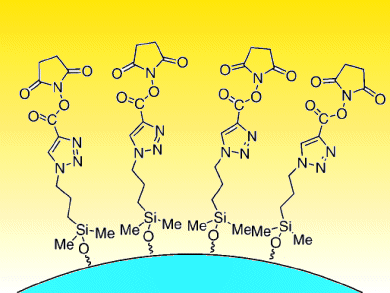The common methods for preparing N-hydroxysuccinimidyl (NHS)-ester group-functionalized solid surfaces are multistep solid-phase synthetic processes. Chul-Ho Jun and co-workers, Yonsei University, Korea, describe the grafting of NHS-ester dimethylmethallyl-silane onto mesoporous silica balls using a single catalytic process. The reaction proceeded at room temperature in the presence of 10 mol% Sc(OTf)3. A model enzyme, glucose oxidase (Gox), could then be covalently immobilized on the silica balls through reaction of the amine group on a lysine side-chain of Gox.
Balls with immobilized enzyme could be obtained with a high loading rate compared to conventional multistep grafting methods.
The stability, reliability, and recyclability of enzymes can be enhanced by immobilization onto a solid support. It also allows facile separation from reaction mixtures and prevents enzymatic contamination of products.

Images: (c) Wiley-VCH
- Facile One-Step Catalytic Grafting of N-Hydroxysuccinimidyl-Ester-Functionalized Methallylsilane onto Silica for Enzyme Immobilization
U.-Y. Jung, J.-W. Park, E.-H. Han, S.-G. Kang, S. Lee, C.-H. Jun,
Chem. Asian J. 2011.
DOI: 10.1002/asia.201000713




